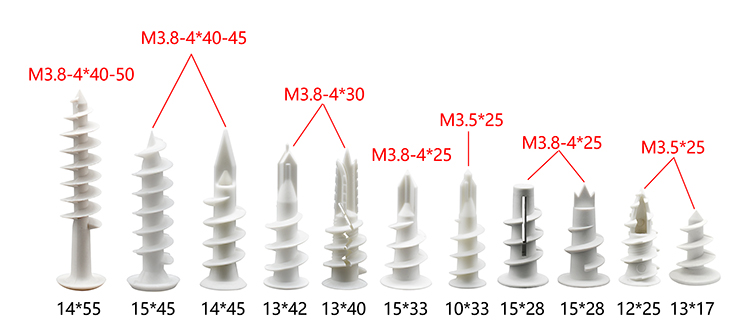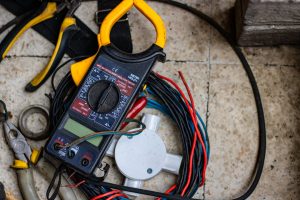Choosing the right drill bit size for your wall anchors can be tricky. If you pick one that’s too big, your anchor won’t hold.
Too small, and you might crack the wall or struggle to insert it. This guide is here to make that decision easy for you. With the Wall Anchor Drill Bit Size Chart, you’ll quickly find the perfect match for your project.
Keep reading, and you’ll save time, avoid mistakes, and get your anchors set up strong and secure every time.

Credit: www.angi.com
Types Of Wall Anchors
Wall anchors hold screws in different wall materials. They help hang items safely on walls.
Choosing the right wall anchor depends on the wall type and weight of the item.
Plastic Expansion Anchors
Plastic expansion anchors are common for light loads. They work well in drywall and masonry.
When a screw enters the anchor, it expands to grip the wall tightly.
- Easy to install with a pre-drilled hole
- Best for hanging pictures and small shelves
- Not for heavy or vibrating loads
Toggle Bolts
Toggle bolts hold heavy objects on hollow walls. They have spring-loaded wings that open inside the wall.
The wings spread the load over a large area, giving strong support.
- Require a larger hole for installation
- Good for heavy shelves and cabinets
- Need a drill bit size matching the folded wings
Molly Bolts
Molly bolts are metal anchors for hollow walls. They expand inside the wall as you tighten the screw.
This expansion makes a strong grip and prevents the anchor from pulling out.
- Good for medium to heavy loads
- Used for wall fixtures and brackets
- Need a hole drilled to the size of the molly bolt body
Self-drilling Anchors
Self-drilling anchors do not need a pre-drilled hole. They screw directly into drywall or plaster.
They are quick to install and hold light to medium loads well.
- Made from metal or plastic
- Ideal for pictures and light shelves
- Use a drill bit size only if pilot holes are needed
Choosing The Right Drill Bit
Choosing the correct drill bit is important for a strong wall anchor hold. The right size and type help avoid damage.
This guide explains how to match drill bits to anchor sizes and wall materials for best results.
Matching Drill Bit To Anchor Size
Each wall anchor has a recommended drill bit size. Using the correct drill bit ensures a tight fit.
| Anchor Size (mm) | Drill Bit Size (mm) |
| 5 | 5 |
| 6 | 6 |
| 8 | 8 |
| 10 | 10 |
| 12 | 12 |
Material Considerations
Wall material affects drill bit choice. Hard materials need stronger bits. Soft walls need less force.
- Concrete: Use carbide-tipped bits for durability.
- Brick: Use masonry bits for clean holes.
- Drywall: Use standard bits carefully to avoid damage.
- Wood: Use wood bits for smooth drilling.
Drill Bit Types For Different Walls
Different walls need specific drill bits. Choosing the right type keeps the wall intact.
| Wall Type | Recommended Drill Bit |
|---|---|
| Concrete | Carbide-tipped Masonry Bit |
| Brick | Masonry Bit |
| Drywall | Standard Twist Bit |
| Wood | Spade or Brad Point Bit |
Common Drill Bit Sizes For Wall Anchors
Wall anchors need the right drill bit size to fit well. Using the correct size keeps anchors strong and safe.
This guide shows common drill bit sizes for different wall anchors. It helps you pick the right bit for your project.
Sizes For Plastic Anchors
Plastic anchors are popular for light loads. They need drill bits that match the anchor’s outer diameter.
- 1/8 inch anchor: Use 3/16 inch drill bit
- 3/16 inch anchor: Use 1/4 inch drill bit
- 1/4 inch anchor: Use 5/16 inch drill bit
- 3/8 inch anchor: Use 1/2 inch drill bit
Sizes For Toggle Bolts
Toggle bolts hold heavy items on hollow walls. Drill bits must fit the folded toggle wings.
- 1/8 inch toggle bolt: Use 3/8 inch drill bit
- 3/16 inch toggle bolt: Use 1/2 inch drill bit
- 1/4 inch toggle bolt: Use 5/8 inch drill bit
- 3/8 inch toggle bolt: Use 3/4 inch drill bit
Sizes For Molly Bolts
Molly bolts expand inside the wall for a firm hold. Drill bits should match the sleeve diameter.
- 1/8 inch molly bolt: Use 3/8 inch drill bit
- 3/16 inch molly bolt: Use 7/16 inch drill bit
- 1/4 inch molly bolt: Use 1/2 inch drill bit
- 3/8 inch molly bolt: Use 5/8 inch drill bit
Sizes For Self-drilling Anchors
Self-drilling anchors cut their own hole. They usually need a pilot hole that is smaller.
- 6 anchor: Use 1/8 inch drill bit pilot hole
- 8 anchor: Use 5/32 inch drill bit pilot hole
- 10 anchor: Use 3/16 inch drill bit pilot hole
- 12 anchor: Use 7/32 inch drill bit pilot hole

Credit: www.explorationcoredrilling.com
Step-by-step Drilling Tips
Drilling into walls requires precision and care. Using the right drill bit size is crucial for a secure anchor.
Follow these steps to ensure your project is successful without damaging your walls.
Marking Drill Points
Accurate marking is the first step to a perfect drill. Use a pencil to mark your drill points clearly.
- Measure twice, mark once to avoid mistakes.
- Use a level to ensure straight lines.
- Consider using tape to catch dust.
Drilling Techniques
Proper techniques make drilling easier and safer. Always maintain a steady hand and apply even pressure.
| Wall Type | Recommended Drill Bit Size |
| Drywall | 1/4 inch |
| Brick | 3/8 inch |
| Concrete | 1/2 inch |
Avoiding Wall Damage
Avoid damage by choosing the right tools and techniques. Ensure your drill bit is suitable for the wall material.
Tip: Always wear safety goggles to protect your eyes from debris.
Troubleshooting Fit Issues
Choosing the right drill bit size for wall anchors is important. Fit issues can cause weak holds or damage. This guide helps fix common problems with anchor fits.
Check your drill bit and anchor sizes carefully. Small mistakes can lead to anchors being too loose or too tight. Learn how to fix these problems and handle crumbling walls.
Anchor Too Loose
If the anchor moves inside the hole, it is too loose. This can happen if the drill bit hole is too big for the anchor.
Try these tips to fix a loose anchor:
- Use a smaller drill bit size to match the anchor.
- Fill the hole with wood glue or epoxy before inserting the anchor.
- Use a larger anchor for a tighter fit.
Anchor Too Tight
An anchor that is hard to insert or cracks the wall is too tight. This often happens when the drill bit hole is too small.
Follow these steps to fix a tight anchor:
- Use a slightly larger drill bit to make the hole bigger.
- Drill slowly and check the fit often.
- Avoid forcing the anchor to prevent wall damage.
Dealing With Crumbling Walls
Crumbling walls need special care. Anchors may not hold well if the wall is weak or damaged.
Try these tips for crumbling walls:
- Use wall anchors made for drywall or plaster.
- Drill a clean hole without widening it too much.
- Consider using toggle bolts for better support.
- Fill cracks with wall filler before installing anchors.

Credit: www.alibaba.com
Maintaining Drill Bits
Drill bits need care to last long and work well. Keeping them clean and sharp helps you drill holes easily.
Good maintenance saves money and improves safety when using drill bits for wall anchors.
Cleaning And Sharpening
Clean drill bits after each use to remove dirt and dust. Use a brush or cloth for cleaning.
Sharpen drill bits to keep the edges strong. Sharp bits cut better and reduce effort.
- Use a sharpening stone or drill bit sharpener
- Hold the bit at the correct angle while sharpening
- Sharpen both cutting edges evenly
- Wear safety glasses during sharpening
Storage Tips
Store drill bits in a dry place to stop rust. Keep them in a case or holder to avoid damage.
Organize bits by size to find the right one quickly. This also prevents them from knocking together.
- Use a drill bit case or organizer
- Keep bits separated by size and type
- Avoid damp or humid storage areas
- Apply light oil to bits before storing for extra protection
When To Replace Drill Bits
Replace drill bits if they are dull beyond sharpening. Worn bits can break or damage your work.
Check bits for cracks, chips, or bent shafts. These signs mean it is time to get new bits.
- Bits that overheat often lose their hardness
- Bits that produce rough holes need replacement
- Broken or chipped edges reduce drilling accuracy
- Worn bits increase the risk of drill slipping
Frequently Asked Questions
What Drill Bit Size Matches Wall Anchor Size?
Choose a drill bit that matches your wall anchor’s diameter. Check the chart for exact size pairs. Using the right bit ensures a secure fit and prevents wall damage.
How To Use A Wall Anchor Drill Bit Size Chart?
Find your anchor size on the chart, then match it to the recommended drill bit. This guide helps you drill the perfect hole size for a strong anchor hold.
Can Wrong Drill Bit Size Damage Wall Anchors?
Yes, using the wrong drill bit size can cause anchors to loosen or break. Too large a hole reduces grip, while too small makes insertion difficult.
Why Is Drill Bit Size Important For Wall Anchors?
Proper drill bit size ensures anchors fit snugly, providing maximum support. It prevents wall damage and anchor failure, making your installation safe and durable.
Conclusion
Choosing the right drill bit size helps your wall anchors hold strong. Using the chart makes this task simple and clear. It saves time and prevents mistakes during your project. Always double-check the size before drilling. A proper fit means better safety and lasting results.
Keep this guide handy for any wall anchor work. Small details like size matter a lot. Happy drilling and secure mounting!








